

Injected Funny Cars: How it was
They may not have sported superchargers, but it's clear that, pardon the pun, injected Funny Cars have blown a lot of people away over the years, at least based on the outpouring of info that the last few columns has inspired.
I received a great e-mail from Jeff Foulk, who ran the Finagler Cougar flopper on the injected circuit in the late 1960s and early 1970s. He offered an interesting perspective on the whole blown-vs.-injected Funny Car comparison that I thought was well worth sharing.
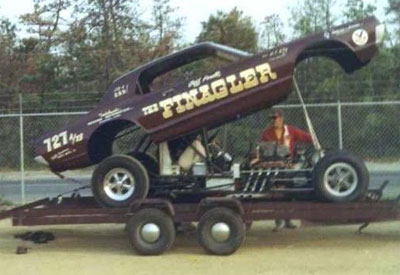 |
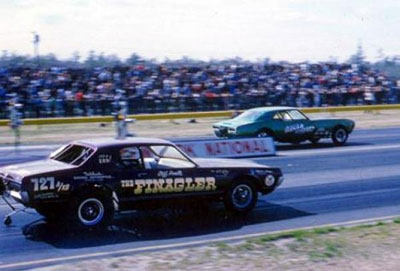 |
"As a participant in the birth of the Funny Car era and a veteran member of the East Coast Fuel Funny Car Circuit, from '69 through '72, I am proud and happy to share our memories and knowledge with the younger fans. This was a unique and memorable time, and its history is the legacy of those of us who were lucky enough to have been in that place at that time.
"While there were always blown Funny Cars [Chrisman's Comet comes to mind], the injected cars were quicker and ruled the class up until the '68 Nationals at Indy, when tires and other developments came together to set the stage for the blown cars to take over. The great thing about that period of time was that almost anyone could build and race a car and be somewhat competitive and make money. You didn't need a ton of money, yours or a sponsor's.
"When my Finagler Cougar was a featured car in a '67 issue of Super Stock and Drag Illustrated magazine, one of the companion articles was about 'Jungle Jim' and his Nova Funny Car. They completely disassembled the car to detail the cost. The grand total, including the transporter, was $25, 000! For a topflight operation! While I didn't have that kind of dough invested in mine, I could have -- through sponsors and partnerships -- raised that kind of cash in that time period. Anyone with the initiative could do it back then. It didn't cost 4 million bucks to race a season. 'Jungle' obviously ran a lot more than 24 dates and made a lot more profit than can be earned today. The only reason more people didn't do it, I can only chalk up to a lack of imagination and self-confidence.
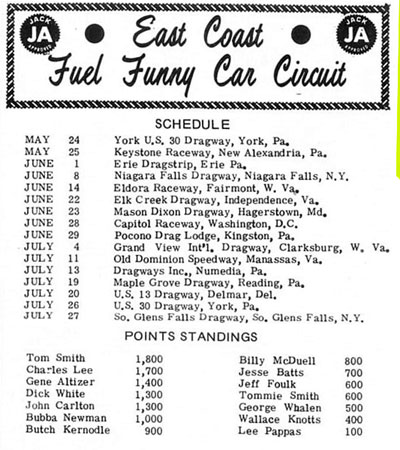
Here's a look at a partial schedule and points standings for the 1969 East Coast Fuel Funny Car Circuit.
|
"There were far more cars back then and a lot more opportunities to race for money. I dare say that on any given summer week during '67 through the '70s, there would be two to five Funny Car shows on the East Coast. I can't speak for the rest of the country, but I suspect that the scenario was similar, especially in the Midwest. The Funny Cars were new and exciting, and the fans couldn't get enough of them. The costs were not prohibitive; the promoters could book a good show and make money, and the fans just kept coming. There has never been a phenomenon in auto racing that I can compare it to. We just showed up and ran. We basically made it up as we went along. Run what you brung was the basic 'rule.'
"As the blown cars slowly assumed preeminence, those of us who chose (or had) to stay with injectors collected on the various injected circuits that blossomed to fill the gaps in the promoters' budgets. Injected circuits were a good deal all around. The promoters could afford a multicar show, and the racers could still make some money. The ECFFC traveled all up and down the East Coast, especially the South. In the '69 season, we would typically show up with 12 or more cars and qualify an eight-car show. In the '70 season, the circuit split, with the top eight guys booked in and eight of the older or slower cars running a second circuit. This is the role we played through '70 and '71, although we filled in on the big circuit quite a few times with pretty good results.
"I will share with you a memory that might illuminate the extent of the original Funny Car craze. In late May or early June of 1966, we entered a race at York U.S. 30 Dragway in York, Pa. This was one of the nicest tracks around in those days. We were running our '66 Mustang in C/XS with our 348-cubic-inch motor and four Webber carbs. The NHRA had just instituted the X/S classes that year. C/XS was on gas and was a little like Pro Stock, except the rules were a little looser.
"Just about every name car was there, with the exception of 'Jungle Jim' and 'Dyno Don.' Everybody ran -- no qualifying -- with the class winners coming back to run for an overall eliminator as was the custom back then. I don't know how many entries they had, but it seemed like there were 100 Funny Cars of all descriptions there. The stands were packed to overflowing, and the feel was electric.
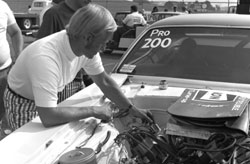 |
"One of the most anticipated early-round races was between Ronnie Sox, in the Sox & Martin stretched Barracuda, and Huston Platt, in his Chevy. Platt had recently become the first Chevy-powered car in the eights. The car was a steel body, completely stripped, with no windows. It was either a Chevelle or Chevy II; I'm not sure which. The car was the most stone-crude piece I ever saw; calling it spartan would be kind. They left even, but Soxie stood the 'Cuda straight up on the rear bumper. He stayed with it, brought it back down, and won the round. Towing back the return road, Ronnie was struggling to steer the car because he had bent the front axle and smashed the header collectors down to the thickness of a cigarette pack! The crowd was literally falling out of the stands over the run. A while later, Eddie Schartman also stood his flip-top Comet straight up. The next morning, Eddie and his crew were standing in the motel parking lot, scratching their heads wondering what to do about that. The wheelie bar probably evolved from that night's events.
"This was during the period before bleach or wet burnouts. A lot of guys were using rosin or liquid traction compound. If you dissolved rosin with some nitro, you came up with a sticky liquid, the precursor of VHT. The burnout ritual entailed three burnouts through the rosin, which worked up the crowd but took quite a while to perform. As a result, the races took a long time to play out. Nobody seemed to mind; they were eating it up. We left at 3:30 a.m., and class eliminations were still going. From 8 o'clock on, the only cars to run were Funny Cars. I felt sorry for those poor local racers who spent a long evening in the staging lanes. It was quite a night."
Wow. Thanks, Jeff, for an outstanding and detailed look back at that wondrous time. I almost felt as if (and definitely wish) I were there!

 |
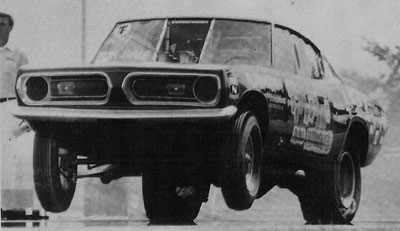 |
Foulk's Finagler Cougar, by the way, is being restored. I also received photos and e-mails from Susie and Dave Koffel reminding me of their great injected car, The Flintstone Flyer, which recently was restored.
"As the 'family historian,' I wanted to pass on a few pictures and articles on our original AXS '67 and '68 injected Barracuda Funny Car that we restored and debuted in 2008," wrote Susie. "It won the XS class at the 1968 NHRA Winternationals in Pomona, 1968 NHRA Springnationals at Englishtown, and finally the 1968 NHRA U.S. Nationals in Indianapolis. In fact, that Indy win was the last run in the car for Dave as he had already joined the Chrysler race group, and they let him finish his race season.
"Last year, the restored car was featured at the Glenmoor Gathering Concours, along with our two original gasser Flintstone Flyers, and then was in Hot Rod magazine with a six-page feature. The photo shoot for that article was at the Glenmoor Gathering, and we enjoyed a reunion of 14 members of our old crew at the same time. This year, it will be in the Concours d'Elegance of America at St. John's in Michigan (the new location of the Meadowbrook Concours). It's hard to imagine that a Funny Car is now Concours material!"
The interesting car name Flintstone Flyer was coined during Koffel's original gasser days. Being a rather stocky German in a 4400-pound Packard race car, one of the team's old crew members said he looked like Fred Flintstone and the car would be something right out of Bedrock, and the name stuck.
OK, enjoy the weekend. There's more injected Funny Car stuff in the future, including a chat with Ron Pellegrini, who was one of the founding members of UDRA and a circuit director for the Funny Car circuit.



















































